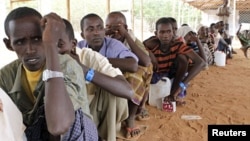East Africa's three-year drought worsens every day, driving people in Somalia and areas of Kenya and Ethiopia from their homes in search of food, water and relief. Aggravating the situation, international aid is being greatly restricted, and in many instances blocked entirely, by al-Shabaab, the terrorist group linked to al-Qaeda that is fighting to bring down Somalia's transitional federal government. Thousands have died and millions more are suffering in the world’s worst humanitarian crisis.
Reports from inside Somalia indicate that some 2,000 refugees arrive in Kenya and Ethiopia every day, while others are fleeing to a relief facility in Somalia itself near the capital, Mogadishu. The numbers are expected to climb as the famine conditions spread to encompass all of southern Somalia in the coming months.
The United States commends the governments of Kenya, Ethiopia and Djibouti for their generous support for refugee populations. Continuing to open their borders is critical to providing the tens of thousands of displaced with safe asylum and life-saving assistance. It is also important, however, that humanitarian aid be available to people close to their homes. If drought victims were able to receive needed aid inside Somalia, many would not have to flee to neighboring countries seeking aid. Expanding access for humanitarian aid workers in southern Somalia prevents vulnerable people from having to travel long distances for assistance, saving countless lives.
In short, the drought and famine in the Horn of Africa have created a multi-faceted crisis requiring a multi-faceted response. It is also an international crisis requiring an international response.
The United States has provided $459 million in humanitarian aid for the eastern Horn of Africa so far this year. This includes more than $80 million in assistance for those in need in Somalia. We are working with the international community to aggressively seek access for humanitarian aid workers in southern Somalia. And we call on other donors to step up both to aid the relief effort and strengthen the region's capacity to respond to future crises.
Somali Refugees An International Responsibility

East Africa's drought worsens every day, driving people in Somalia and areas of Kenya and Ethiopia in search of food, water and relief.




















